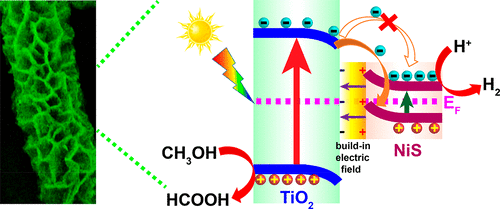当前位置:
X-MOL 学术
›
ACS Sustain. Chem. Eng.
›
论文详情
Our official English website, www.x-mol.net, welcomes your feedback! (Note: you will need to create a separate account there.)
Direct Z-Scheme TiO2/NiS Core–Shell Hybrid Nanofibers with Enhanced Photocatalytic H2-Production Activity
ACS Sustainable Chemistry & Engineering ( IF 8.4 ) Pub Date : 2018-07-19 00:00:00 , DOI: 10.1021/acssuschemeng.8b02710 Feiyan Xu 1 , Liuyang Zhang 1 , Bei Cheng 1 , Jiaguo Yu 1, 2
ACS Sustainable Chemistry & Engineering ( IF 8.4 ) Pub Date : 2018-07-19 00:00:00 , DOI: 10.1021/acssuschemeng.8b02710 Feiyan Xu 1 , Liuyang Zhang 1 , Bei Cheng 1 , Jiaguo Yu 1, 2
Affiliation

|
Photocatalytic water splitting to generate hydrogen (H2) is a sustainable approach for solving the current energy crisis. A novel TiO2/NiS core–shell nanohybrid was fabricated where few-layer NiS nanoplates were deposited on TiO2 skeletons via electrospinning and hydrothermal methods. The NiS nanoplates with a thickness of ca. 28 nm stood vertically and uniformly upon the TiO2 nanofibers, guaranteeing intimate contact for charge transfer. XPS analysis and DFT calculation imply that the electrons in NiS would transfer to TiO2 upon hybridization, which creates a built-in electric field at the interfaces and thus facilitates the separation of useful electron and hole upon photoexcitation. In-situ XPS analysis directly proved that the photoexcited electrons in TiO2 migrated to NiS under UV–visible light irradiation, suggesting that a direct Z-scheme heterojunction was formed in the NiS/TiO2 hybrid. This direct Z-scheme mechanism greatly promotes the separation of useful electron–hole pairs and fosters efficient H2 production. The hybrid nanofibers unveiled a high H2-production rate of 655 μmol h–1 g–1, which was 14.6-fold of pristine TiO2 nanofibers. Isotope (4D2O) tracer test confirmed that H2 was produced from water, rather than from any H-containing contaminants. This work provides an alternative approach to rationally design and synthesize TiO2-based photocatalysts with direct Z-scheme pathways toward high-efficiency photogeneration of H2.
中文翻译:

具有增强的光催化H 2的直接Z型TiO 2 / NiS核-壳杂化纳米纤维-生产活性
光催化水分解产生氢(H 2)是解决当前能源危机的可持续方法。制备了一种新颖的TiO 2 / NiS核壳纳米杂化体,其中通过电纺丝和水热方法在TiO 2骨架上沉积了几层NiS纳米板。NiS纳米板的厚度约为。28 nm垂直且均匀地竖立在TiO 2纳米纤维上,确保紧密接触以进行电荷转移。XPS分析和DFT计算表明,杂交后NiS中的电子会转移到TiO 2上,这会在界面处产生内置电场,从而在光激发时促进有用电子和空穴的分离。原位XPS分析直接证明了TiO 2中的光激发电子在紫外可见光照射下迁移到NiS,这表明在NiS / TiO 2杂化物中形成了直接的Z型异质结。这种直接的Z方案机制极大地促进了有用的电子-空穴对的分离,并促进了有效的H 2产生。杂化纳米纤维的高H 2生成速率为655μmolh –1 g –1,是原始TiO 2纳米纤维的14.6倍。同位素(4 D 2 O)示踪剂测试证实了H 2是由水而不是由任何含H的污染物产生的。这项工作提供了一种替代方法,可以合理设计和合成具有直接Z方案途径的TiO 2基光催化剂,从而实现H 2的高效光生。
更新日期:2018-07-19
中文翻译:

具有增强的光催化H 2的直接Z型TiO 2 / NiS核-壳杂化纳米纤维-生产活性
光催化水分解产生氢(H 2)是解决当前能源危机的可持续方法。制备了一种新颖的TiO 2 / NiS核壳纳米杂化体,其中通过电纺丝和水热方法在TiO 2骨架上沉积了几层NiS纳米板。NiS纳米板的厚度约为。28 nm垂直且均匀地竖立在TiO 2纳米纤维上,确保紧密接触以进行电荷转移。XPS分析和DFT计算表明,杂交后NiS中的电子会转移到TiO 2上,这会在界面处产生内置电场,从而在光激发时促进有用电子和空穴的分离。原位XPS分析直接证明了TiO 2中的光激发电子在紫外可见光照射下迁移到NiS,这表明在NiS / TiO 2杂化物中形成了直接的Z型异质结。这种直接的Z方案机制极大地促进了有用的电子-空穴对的分离,并促进了有效的H 2产生。杂化纳米纤维的高H 2生成速率为655μmolh –1 g –1,是原始TiO 2纳米纤维的14.6倍。同位素(4 D 2 O)示踪剂测试证实了H 2是由水而不是由任何含H的污染物产生的。这项工作提供了一种替代方法,可以合理设计和合成具有直接Z方案途径的TiO 2基光催化剂,从而实现H 2的高效光生。



























 京公网安备 11010802027423号
京公网安备 11010802027423号